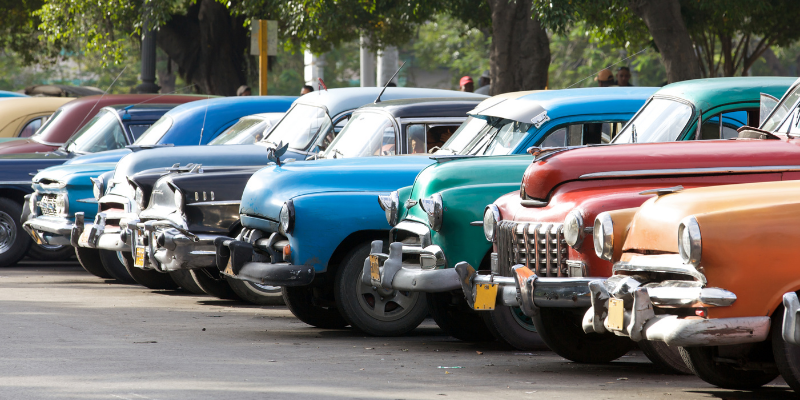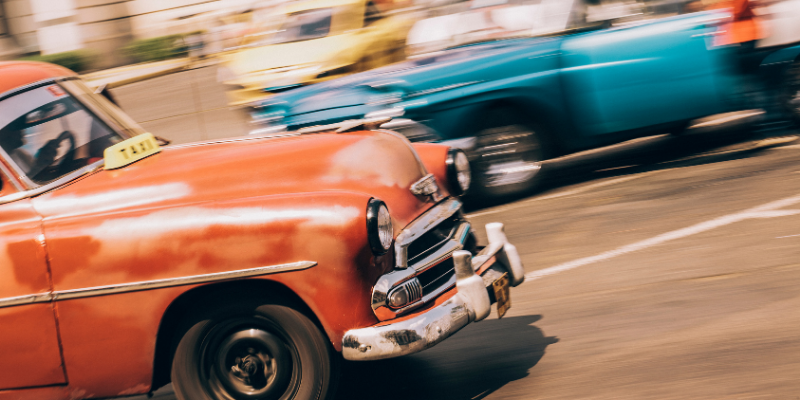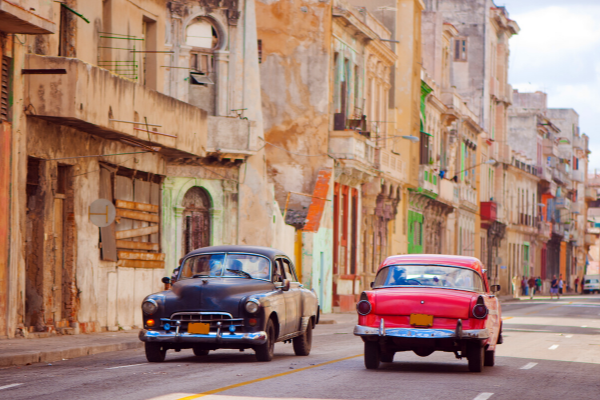CUBA
Cuba’s Classic Cars
By Anna Wainwright
Chapel Hill, NC, United States
In 1898 the first automobile arrived in Cuba from France. Within a decade, most cars in Cuba came from factories in the United States.
During the first half of the 20th century, Cuba proved to be a profitable market for US-based automobile manufacturers. High demand combined with low taxes allowed Cuba to rank second in the hemisphere in per capita car ownership.
In 1956 approximately 143,000 US-made cars, known as Yank tanks, were traveling Cuban roads, 95,000 in Havana alone. In some cases, new models were tried out in Cuba before appearing on showroom floors in the US.
Revolution Restrictions
This influx came to a halt with the Cuban Revolution in 1959. The country’s new leader, Fidel Castro, seized US-owned businesses such as factories and banks. He also levied heavy taxes on US imports. In response, the US imposed a trade embargo. As a result, Cubans couldn’t buy new cars or supplies to repair their old ones.
Cuban car owners had to be resourceful to keep their vehicles running. They learned how to fix their cars themselves. They adapted parts imported from trade partners like the Union of Soviet Socialist Republics and other communist nations. Because new cars were impossible to purchase, most automobiles were passed down from one generation to the next as family heirlooms.

History on the Road
Driving the streets of Cuba today is like traveling back in time. Vibrantly colored cars from the 1930s, 1940s, and 1950s create a rolling museum. Of the approximately 70,000 classic cars in Cuba, experts estimate that about half of these cars are from the 1950s, one-fourth from the 1940s, and one-fourth from the 1930s.
In 2014 the sale and purchase of cars became legal under strict government controls. Often priced at four times the factory rate, a new car was so expensive that only the wealthiest Cubans could afford one. The average monthly wage in Cuba then was less than US$100.
Earning Money
Classic cars are a source of income for their owners as both rentals and taxis. Tourists hire drivers to take them on scenic routes around the capital city of Havana. Riding along the Malecón oceanfront in a well-kept, vintage convertible is an experience to savor, especially at sunset.
Classic cars are also used by taxi companies. Local Cubans rather than tourists are most likely to ride in these taxis. They are often retrofitted to hold more passengers than originally planned. As a result of all the wear and tear, these cars are typically not in mint condition.

No matter if vintage cars are driving locals or tourists, they remain a charming staple of Cuban culture. What would happen to them if the US lifted its trade embargo? With spare parts readily available, these vehicles might roll on into another century.
Have a suggestion for this story? We’d love for you to submit it!


Blank
Blank
Math Resources
Learning Activity:
Sample Problems:
- If there were 143,000 cars in Cuba when the US imposed its embargo, and 70,000 are left now, what percentage of the original amount remains?
- In the 1950s the average car made about 13 miles per gallon. In Cuba, the price of gas is about US$4.75 per gallon, and the average monthly income is about US$150 per month. If you were a taxi driver, how much would you charge someone to travel from Bauta to Castillo de San Salvador de la Punta, a restored harbor fortress near Havana? The trip is 20 miles long and takes about 45 minutes. How much would you charge someone for a two-mile, 20-minute trip in downtown Havana? Is such a trip affordable for the average Cuban?
- A restored 1955 Chevrolet Bel Air in average condition sells for about US$45,000 in the US. How long would the average Cuban need to work to afford such a vehicle? If a car dealer in the US traveled to Cuba to purchase a Bel Air, how much money do you think the dealer would have to offer its owner to purchase it? Is this a fair amount? What would a fair amount be?
- Estimate how many cars from the 1930s, 1940s, and 1950s are currently in Cuba.
- Plan a trip from Havana, the capital, to Santiago de Cuba. How much will the total trip cost? If you have access to the internet, determine some things you might do when you stay in Santiago de Cuba.
- Looking at a parking lot in Havana, you see 20 cars from the 1930s, 15 cars from the 1940s, and 60 cars from the 1950s. The remaining 100 cars are from other decades. Is this ratio about the same as the ratio of cars from the rest of the country? If not, propose the number of vehicles from each decade you would expect.
- My mother can fit eight people into her 1953 Bel Air station wagon, and my neighbor can bring more people in his car. I have invited 11 classmates to the beach with me. How many people will my neighbor need to bring in his car? (Hint: the answer is not three.)
- You have saved 300 Cuban pesos (CUP) to go to the grocery store. Taxi fare to the store is 40 CUP each way. How much can you spend on groceries? One CUP is equal to US$.042.
Social Justice Questions
- Do you think that owning a means of transportation is a right? Explain your reasoning.
- The decades-long US trade embargo with Cuba uses economic pressure to force the Castro regime to improve human rights. Not much progress has occurred since it began. Do you believe it should be continued?
Explore Further
1. General information from
2. A description of driving the Malecón
3. Video about classic cars as a source of income
3. Timeline of US-Cuba relations
4. Information about Cuba before the revolution
Share Your Story
Write your own Global Math Story and send it to us!
Sorry, the comment form is closed at this time.